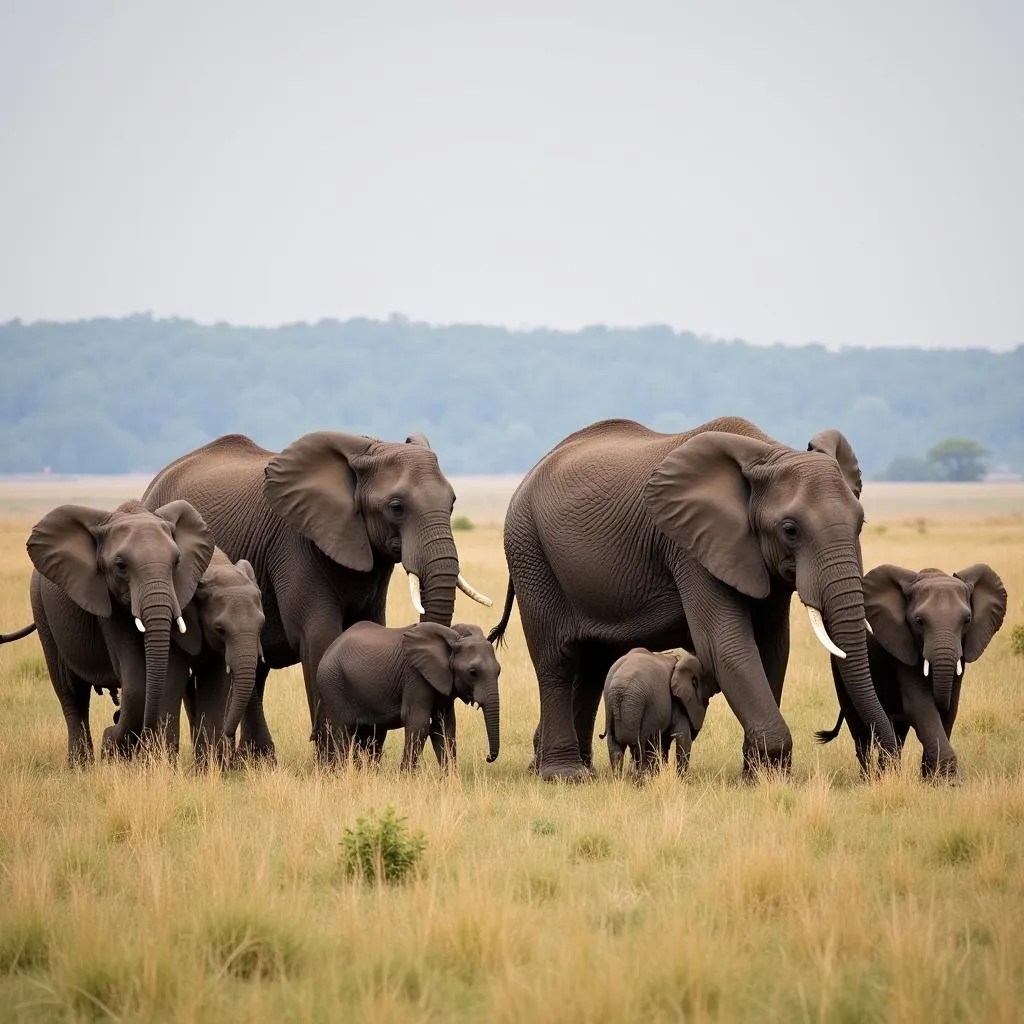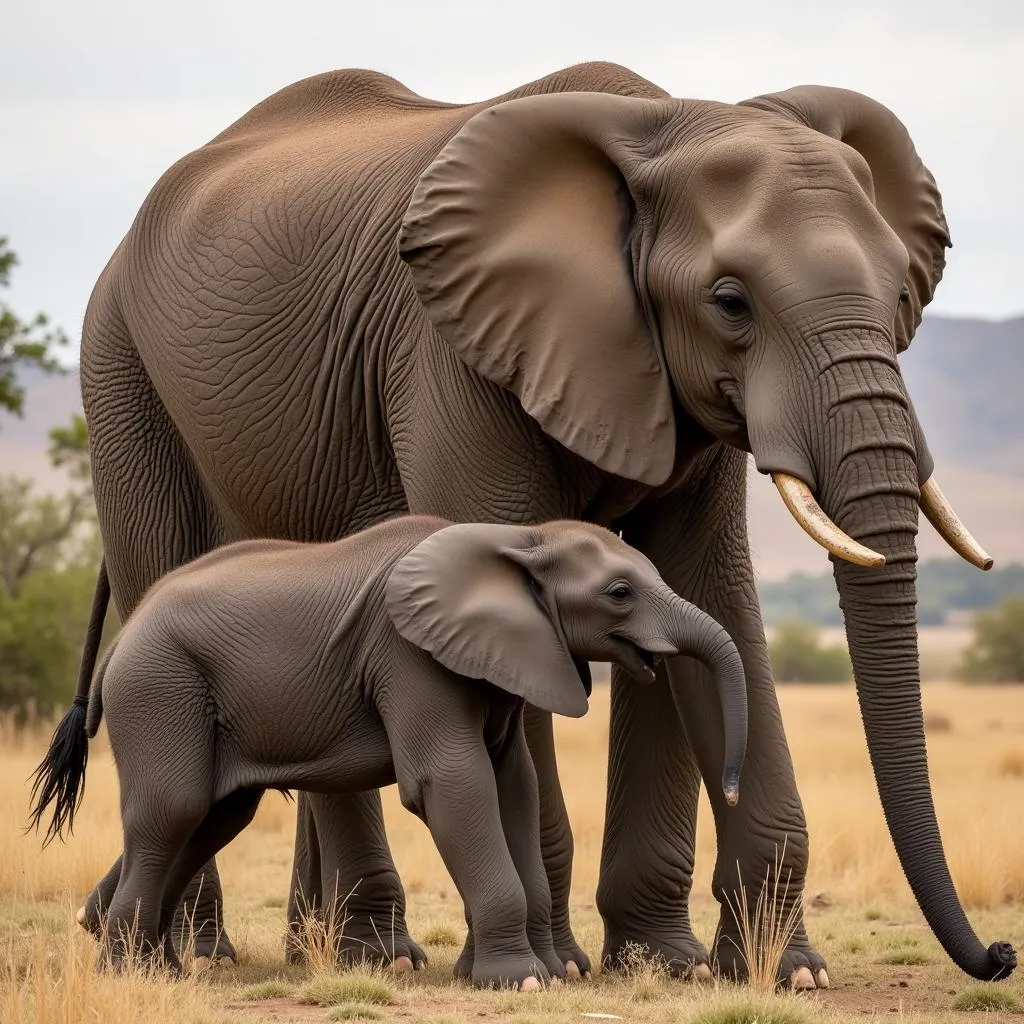The African bush elephant, known as the “अफ्रीकी झाड़ी हाथी” (Afreeki Jhadi Haathi) in Hindi, is a majestic creature that roams the savannas of Africa. This gentle giant, the largest land animal on Earth, holds a place of wonder and respect in the hearts of many. But what is it about the African bush elephant that captivates our imagination and draws us to their world? Let’s delve into the fascinating life of these incredible animals.
Understanding the African Bush Elephant
Standing up to 3.96 meters (13 feet) tall and weighing up to 10.4 tonnes (11.5 short tons), the African bush elephant is hard to miss. Their massive size is complemented by distinctive features: large ears shaped like the African continent, long and curved tusks made of ivory, and a trunk that serves as a multi-purpose tool. But there’s more to these giants than meets the eye.
 Family Group of African Bush Elephants
Family Group of African Bush Elephants
What does “African Bush Elephant” mean in Hindi?
The Hindi translation “अफ्रीकी झाड़ी हाथी” (Afreeki Jhadi Haathi) accurately describes this magnificent animal. “Afreeki” translates to “African,” “Jhadi” means “bush” or “thicket,” and “Haathi” means “elephant.” This directly translates to “African bush elephant,” highlighting their natural habitat on the African savannas.
The Crucial Role of the African Bush Elephant
African bush elephants are not just impressive creatures; they are keystone species, playing a crucial role in their ecosystem. Their impact on the environment is significant and far-reaching.
- Landscape Engineers: They create clearings in the dense bush, making way for new vegetation and shaping the landscape. This benefits other animals by creating open grasslands and watering holes.
- Seed Dispersers: Many plant species rely on elephants to spread their seeds. Elephants consume large quantities of fruit and vegetation, dispersing seeds through their dung over vast distances, promoting plant diversity.
- Water Source Providers: In the dry season, elephants use their tusks and feet to dig for water in dry riverbeds. This not only quenches their thirst but also creates water sources for other animals struggling to survive.
Threats to the African Bush Elephant
Sadly, these gentle giants face numerous threats. Poaching for their ivory tusks has significantly impacted their populations. Habitat loss due to human encroachment and climate change further threatens their survival.
How can we protect the African Bush Elephant?
Protecting the African bush elephant requires a multi-pronged approach:
- Anti-poaching efforts: Strengthening anti-poaching patrols, using technology to monitor elephant populations, and enacting stricter laws against the ivory trade are crucial.
- Habitat conservation: Creating protected areas, promoting sustainable land management practices, and mitigating human-wildlife conflict are essential.
- Raising awareness: Educating people about the importance of elephants and the threats they face is key to fostering a sense of responsibility and encouraging conservation efforts.
The Future of the African Bush Elephant
The future of the African bush elephant hangs in the balance. Their fate depends on our collective action to protect them and their habitat. By understanding their ecological importance, supporting conservation initiatives, and spreading awareness, we can help ensure that these magnificent creatures continue to roam the African savannas for generations to come.
 African Bush Elephant Calf with its Mother
African Bush Elephant Calf with its Mother
FAQs about African Bush Elephants
Here are some frequently asked questions about African bush elephants:
1. What is the lifespan of an African bush elephant?
African bush elephants have a lifespan of 60 to 70 years in the wild.
2. What is the biggest threat to African bush elephants?
Poaching for their ivory tusks is the most significant threat to African bush elephants.
3. How much does an African bush elephant eat in a day?
An adult African bush elephant can consume up to 300 kilograms (660 pounds) of food per day.
4. How do African bush elephants communicate?
Elephants communicate through a variety of sounds, including trumpets, rumbles, and snorts. They also use body language, like ear flapping and head shaking, to convey messages.
5. How can I help protect African bush elephants?
You can support reputable conservation organizations working to protect elephants, spread awareness about their plight, and advocate for policies that protect elephants and their habitat.
Conclusion
The African bush elephant, “अफ्रीकी झाड़ी हाथी” (Afreeki Jhadi Haathi) in Hindi, is a remarkable animal that embodies the beauty and wonder of the natural world. It is our shared responsibility to protect these gentle giants and ensure their survival. By understanding their plight and taking action, we can make a difference in their future and preserve these magnificent creatures for generations to come.
For any assistance or further information, please do not hesitate to contact us:
Phone Number: +255768904061
Email: [email protected]
Address: Mbarali DC Mawindi, Kangaga, Tanzania.
Our dedicated customer service team is available 24/7 to assist you.
Leave a Reply